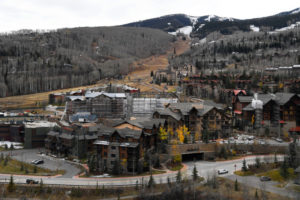The Build-A-Ski Village Model does not work
After failing to capture the magic of Whistler for 20 years, Snowmass Base Village hits restart button on $600M development plan

Analyst: “We don’t have a very good track record with these villages”
By JASON BLEVINS | jblevins@denverpost.com | The Denver Post
PUBLISHED: November 19, 2017 at 12:01 am | UPDATED: November 19, 2017 at 8:14 pm
It’s early on a March morning in 1998. Dozens of couples, fat checks in hand, are huddled around a table in a well-appointed room at the base of Copper Mountain. A model of a new village sprawls before them, part of a $500 million, 10-year plan by Canada’s Intrawest Corp. to transform the largely day-tripping ski hill into a dynamic resort village, with condos stacked above bustling shops, restaurants and bars.
By midday, Intrawest, the largest resort operator at the time, had broken national real estate sales records, selling 104 of the yet-to-be-built condos for $33 million.
The Copper Mountain sales sparked a village-building frenzy that swept through the ski resort industry.
That village fever saw resort companies burning through billions of pre-sale dollars to erect canyons of condos atop street-level shops in eerily similar, timber-gabled villages at resorts like Keystone, Winter Park, Aspen Highlands, Steamboat, Telluride’s Mountain Village, and Squaw Valley and Mammoth in California.
Despite those billions and near-universal adherence to the build-a-village ethos, the model has not worked as planned.
Assessed values and real estate sales in resort villages are depressed, with condo sales rarely reaching the prices buyers paid a decade ago. A steady rotation of entrepreneurs roll through the commercial spaces, few lasting longer than a season or two. Just about all resort village shops are either subsidized or owned and operated by the resort companies, which can backfill slow sales with other revenue to keep storefronts from going dark.
“We don’t have a very good track record with these villages, that’s for sure,” said Ford Frick, a longtime resort community analyst and consultant. “We have built a lot of these with expectations that were not met.”
So there are many lessons for Aspen Skiing Co., KSL Capital Partners and East West Partners as the trio of companies build the Base Village at Snowmass, a 10-year, $600 million plan to finish a project that has languished for more than 20 years.
The Base Village is the first ski resort village project in almost a decade and the first that will attempt to break the failed model of resort villages.
The Snowmass plan goes something like this: Start with a big hotel.
Aspen Skiing is building a 100-room, 11-residence Limelight Hotel, with an indoor-outdoor “community living room” that will mirror the company’s wildly popular Limelights in Aspen and Ketchum, Idaho.
Then create open gathering places, like a community plaza, a five-story climbing wall and an ice rink that in summer transforms into a concert venue and farmers market, surrounded by fire pits that encourage lingering. Deploy an array of architects to design different buildings, lending the village a feel that it evolved organically over many years.
Stir year-round activities, with family-friendly festivals, concerts and Aspen Skiing’s new mountain coaster, ziplines and canopy tours a gondola ride away. Build larger living rooms, kitchens and decks — with smaller bedrooms and bathrooms — in the for-sale condos and make those condo buildings smaller, not colossal towers. Focus on experiential retail shops over storefronts peddling T-shirts and trinkets. Mingle residents, guests and locals in an urban-type scene rich with appealing food, and attractions.
It’s a dream to which every village builder has aspired but few have reached.
East West Partners, which built Beaver Creek Village in the mid-1980s before developing $3 billion worth of village projects and communities, has looked at just about every ski resort real estate opportunity in the West.
“And we passed on most of them,” said Andy Gunion, who is heading East West’s Base Village project at Snowmass. “I’m not sure a village is right for every ski resort.”
That alone is a new tack for resort developers. It wasn’t that long ago that the condo-stacked village was considered essential to a resort’s success. Blame Whistler for that.
Back in the 1980s, resort operators from around the world trekked to British Columbia’s rollicking Whistler Village seeking strategies for growth. Back then, baby boomers were young and ready to buy dream properties where they could rally the family and stroll to ski.
Intrawest came up with the industry-shifting idea of courting those boomers by developing Whistler-inspired villages everywhere. But it turns out the delicate ratios that evolved over decades at the base of Whistler-Blackcomb — a balance of visitors, hotel rooms, retail and restaurant space, all a few steps from many acres of ski terrain — could not be rubber-stamped.
“The Whistler experience is extremely difficult to replicate,” Frick said.
Intrawest pumped $50 million into the ski hill and pays the city $2 million plus incentives every year. In exchange, it built and sold condos at the base. Intrawest spent $70 million on a village moored to a pair of condo buildings that the company sold in 2006 and delivered in 2008, just in time for the economic downturn.
When Fraser Crossing and Founders Pointe came online in 2008 with more than 200 condos, the assessed value of the village was $76.9 million. In 2016, the assessed value of the village — with about 55 more condos and 38 more commercial properties than in 2008 — had dropped about 24 percent, to $58.5 million. For comparison, Grand County saw its total assessed value of all properties fall 11 percent the same period. Fifteen of those Winter Park Village condos have sold this year, with prices down, on average, 32 percent from when they were brand new in 2008.
This winter, all the commercial space in the village is fully rented for the first time in almost a decade. And buyers are rallying now, with Winter Park Village condos selling quickly, yet still at prices well below 2008 levels.
“I can’t keep up with the white-board list of buyers,” said Lisa Leclair Waldorf, owner of Real Estate of Winter Park brokerage. “I think a resistance to the base here is that we have so many local Colorado folk who buy here that want an easy way to let their dog out, sit on a quiet back porch by the trails versus living hotel-style.”
With sweeping new residential projects blossoming in Winter Park, Basalt, Crested Butte South and Silverthorne as well the growing popularity of down-valley hot spots like Edwards, Eagle, Ridgway, Montrose, Carbondale, Glenwood Springs and Gunnison, resort villages are enduring stiff competition for buyers.
When Intrawest sold all those condos at Copper Mountain in 1998, there had been no new development in the previous 15 years. Copper Mountain Village saw its assessed valuation of both residential and commercial properties peak in 2007 at $71.6 million. In 2016, the value was almost identical, while the assessed value of all of Summit County properties climbed 11 percent in that same window.
Real estate sales tracked by Land Title Guarantee Co. in Copper Mountain peaked in 2006 with 219 deals totaling $86.2 million and an average sales price of $375,000. Through September, Land Title recorded 103 deals in Copper Mountain worth $49.4 million, with an average sales price of $479,000. The key to making villages viable is summer, said Aspen Skiing chief Mike Kaplan.
Aspen Skiing has invested almost $100 million into the ski area over the last decade, with new lifts, terrain, restaurants and, most recently, summer activities.
“So many of these village problems go away if you can figure out summer,” said Kaplan, who winces at the idea his Aspen Skiing Co. is a real estate developer, saying he joined KSL and East West at the Base Village to play a role in shaping the permanent anchor for his marquee ski area. “We are in this for the placemaking and creating a year-round destination for the health of our resort business.”
After weathering a recession that decimated companies anchored in real estate, resort operators are rejecting the Intrawest model. With Intrawest a shadow of itself and soon to disappear after its acquisition by KSL Capital Partners and the owners of Aspen Skiing Co., today’s largest resort company, Vail Resorts, tallied less than 1 percent of its $1.9 billion in revenue in 2017 from real estate.
Kaplan said years ago there was a brief internal discussion about developing a village at the largely day-tripped Buttermilk ski area, but that quickly faded. The company already has a struggling village at the base of its Aspen Highlands. Built in 2001 by renowned Texas developer Gerald Hines for $230 million, Aspen Highlands Village has languished for years.
Today, law offices, call centers and investment companies occupy ground-floor space intended for retailers. There are plenty of people offering reasons why Aspen Highlands Village never thrived: no hotel, too few beds in the member-only Ritz Carlton, too little parking, a layout that routes visitors directly to the chairlifts instead of past eateries and shops. Whatever the reason, it’s like a slope-side country club for office workers.
“We call it the dark village,” said Jim Lindsay on a quiet fall afternoon as he customized ski boots for customers who booked his services weeks, if not months, out.
Aspen Highlands Village saw its assessed value peak in 2010, when the Pitkin County assessor valued the village’s commercial properties at $5.6 million and residential properties at $58.3 million. Last year the assessed values for Aspen Highlands Village’s commercial properties had increased to $6.1 million, while residential fell to $40.4 million.
Lindsay has been in the village since 2000. He’s seen plenty of restaurants and businesses come and go. When he originally moved his BOOTech company to Highlands after working in Aspen and Snowmass, he paid an adjusted rent for several years. That same subsidized, sliding-scale rent program was common for villages as developers cultivated a retail scene.
“That encouraged a lot of people to start a business. But then what happened is, after three or four years and you start paying market-value rents, your business model doesn’t work anymore,” said Lindsay, who considers walk-in traffic a distraction.
Aspen Skiing acquired Snowmass’ 500-acre base parcel in the 1990s and partnered with Intrawest. The two companies sold the project to Related WestPac in 2007 for $169 million. Related lost the property but after several lawsuits and bankruptcies regained control of the project in 2012. East West, KSL Capital and Aspen Skiing bought the project back in 2015.
So as Snowmass celebrates its 50th anniversary this season, the resort is finally getting its base village.
In some ways, the delays have given developers time to avoid the pitfalls of other villages.
Aspen Skiing in the late 1990s considered partnering with East West Partners in the project but instead tapped Intrawest, which deployed its Whistler rubber stamp and proposed a 1 million-square-foot, 635-home village. In 2003, the village plan ranked as the largest single project in Pitkin County history. The new owners are tweaking and scaling back those Intrawest designs, hoping to find the elusive formula for a vibrant village. That formula, at its core, is anchored in full hotel rooms and rented condo units, not occasionally occupied residences.
A host of architects, including OZ Architecture, Harry Teague Architects and 4240 Architecture, are designing residential and commercial spaces, providing a less uniform approach than previous village construction.
While the focus on maximizing profit from every square foot has changed, the village has to make money. The builders have spent hundreds of millions dealing with not just mountainside construction, but employee housing, transportation and all the other impacts that come with building in the high country.
“So we need a big economic engine, but we need to balance that against the need for plans that allow us to gather and hang out and see up the mountain and enjoy each other’s company,” Kaplan said.
Architect Rebecca Stone of OZ Architecture has worked on nearly every resort village across the West, starting in the late 1990s with Intrawest at Copper Mountain. She’s seeing the Snowmass Base Village partners focusing a lot more on experiences with a year-round slate of events and more of a focus on hotel rooms over for-sale condos. But most important, Stone said, is the year-round focus. To lure top restaurants and shops, the village will have to bustle all year, not just for a few months in the winter and summer.
“When I started doing resorts in the late ’90s, it was all about winter. Now it’s more than one season. Resorts are now designing for generations that need to do more stuff at a ski area than just ski,” she said. “I think the resort market is getting more popular in the summer than winter, so we are using the outdoors much more in our designs.”
East West developers toured both Lake Tahoe’s Martis Camp and Montana’s Yellowstone Club — two private luxury communities that rank as the biggest success stories in resort development since the recession — for ideas on both design and cultivating an exclusive experience.
But not too exclusive.
“Sometimes, those gated luxury places ignore what a lot of people come to these mountain communities for, and that’s to feel like a local,” Gunion said.

